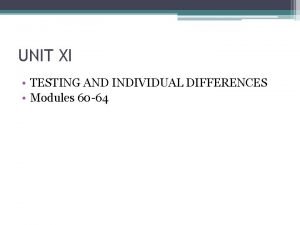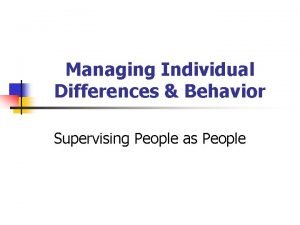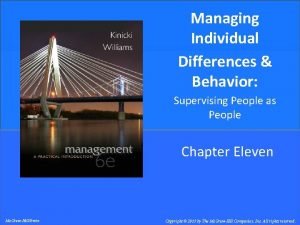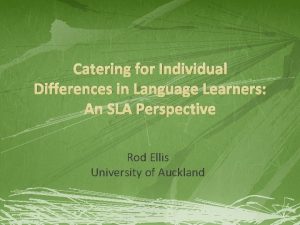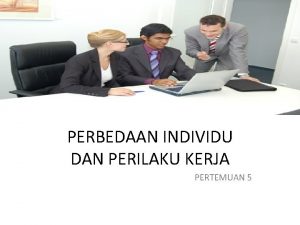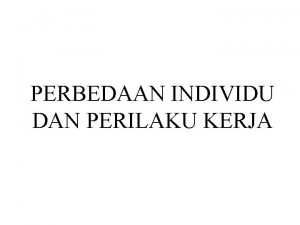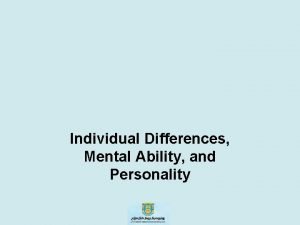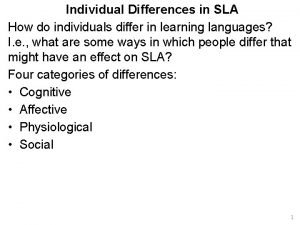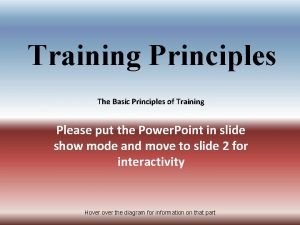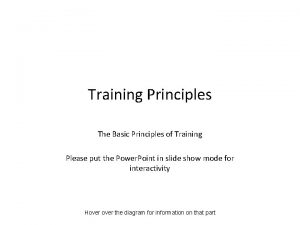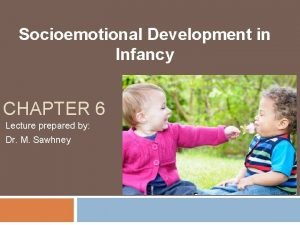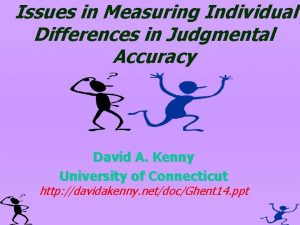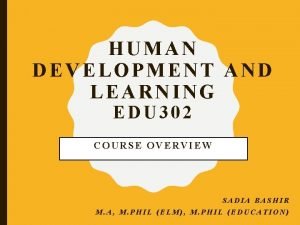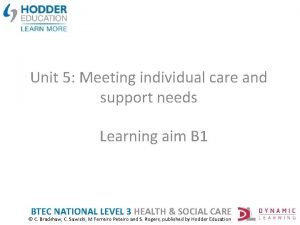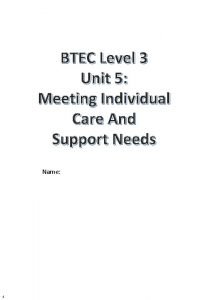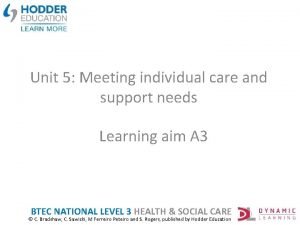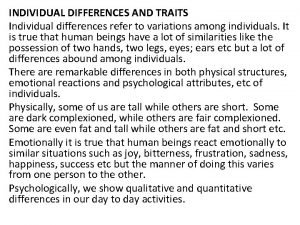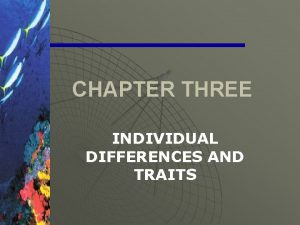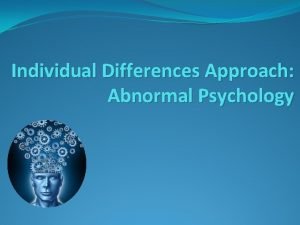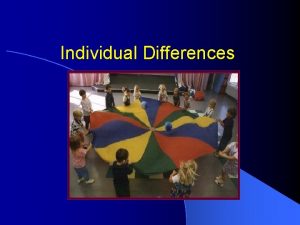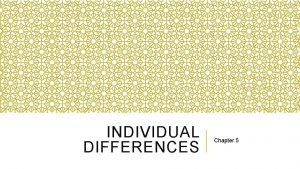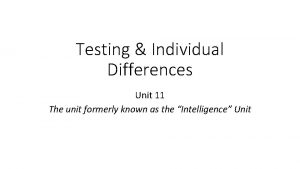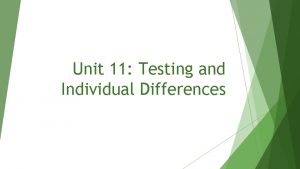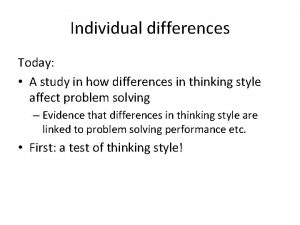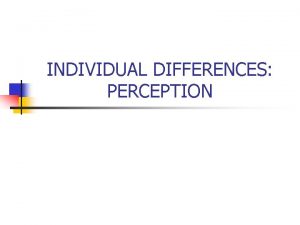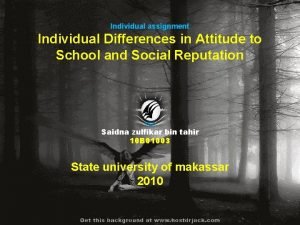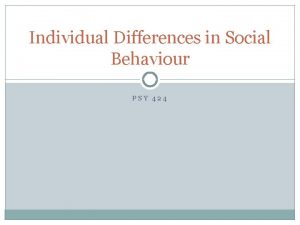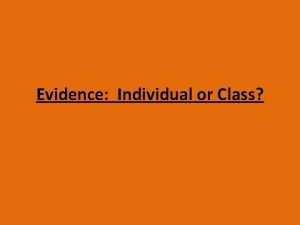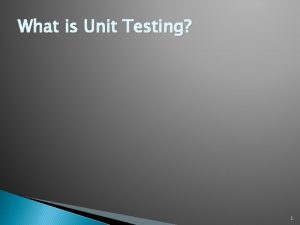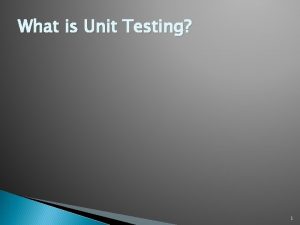Unit XI Testing and Individual Differences Definition of






















- Slides: 22

Unit XI Testing and Individual Differences

“Definition” of Intelligence § Intelligence tests are a series of questions and other exercises which attempt to assess people’s mental abilities in a way that generates a numerical score, so that one person can be compared to another. § Intelligence can be defined as “whatever intelligence tests measure. ” § Your college entrance test measures how good you are at scoring well on that test.

Definition of Intelligence: Beyond the Test? The text defines intelligence, whether it’s math ability or a rainforest dweller’s understanding of plants, as the ability to learn from experience, solve problems, and use knowledge to adapt to new situations.

Intelligence: Single or Multiple? Is intelligence one general ability or several specific abilities? Charles Spearman general intelligence [g] Louis Thurstone 7 linked clusters of abilities Howard Gardner 8 intelligences Robert Sternberg 3 intelligences Creativity and intelligence 5 components Emotional intelligence 4 components

Charles Spearman (1945) • Believes in the idea of a “general intelligence. ” • There is a common skill set that underlies all intelligences. • People who score high in one area tend to score high in related areas. • This is controversial because… • Our intelligences may be too diverse to be guided by one skill factor.

General Intelligence, also known as g Charles Spearman (1863 -1945) performed a factor analysis* of different skills and found that people who did well in one area also did well in another. Spearman speculated that these people had a high “g” (general intelligence). *Factor analysis refers to a statistical technique that determines how different variables relate to each other; for example whether they form clusters that tend to vary together. High verbal skills correlate to high spatial or reasoning ability

L. L. Thurstone (1955) • He did not rank people on a single scale. He identified seven different clusters of mental abilities • However, people who scored high in one area tended to score high in related areas which lends itself to the idea of a “g” factor. • Somewhat like athletic ability. Weight lifters and ice skaters do not share the same types of athleticism. • Speed and throwing a ball may coordinate. Several different abilities tend to cluster together.

Thurstone’s Seven Clusters of Abilities § Louis Thurstone (1887 -1955) disagreed with the idea of one general measure and trait of overall intelligence. 1. Verbal comprehension 2. Inductive § Thurstone found that the reasoning results of 56 skill tests fell into 3. Word fluency 7 clusters. 4. Spatial ability § However, further analysis showed that people who 5. Memory were strong in one cluster 6. Perceptual tended to be strong in speed other clusters. “g” factor? 7. Numerical ability g

Satoshi Kanazawa (2005) • Believes that intelligence develops as we solve problems. • He believes there are two very different types of intelligence. • Evolutionary skills like dating and forming relationships, finding your way back to camp or finding food are different from academic intelligences.

Howard Gardner (1983, 2006) • He believes that intelligences come in different packages. He identified 8 separate intelligences. • Proven by Savant Syndrome • This goes beyond traditional school smarts.

Multiple Intelligences The “savant syndrome” refers to having isolated “islands” of high ability amidst a sea of below-average cognitive and social functioning. Howard Gardner’s Multiple Intelligences § Howard Gardner (b. 1943) noted that different people have intelligence/ability in different areas. § Research and factor analysis suggests that there may be a correlation among these intelligences.

Howard Gardner’s Eight Intelligences

Intelligence and Success “Success in life” is impossible to define. However, wealth tends to be related to intelligence test scores, but it does not always make you successful. PLUS: § focused daily effort/practice, taking 10 years to achieve success-level expertise. § social support and connections. § hard work and energetic persistence (grit). Combination of talent and GRIT lead to success. 13

Sternberg’s Intelligence Triarchy Robert Sternberg (b. 1949) proposed that “success” in life is related to three types of ability. Analytical intelligence: Practical intelligence: expertise and talent that help to complete the tasks and manage the complex challenges of everyday life solving a welldefined problem with a single answer Creative intelligence: generating new ideas to help adapt to novel situations


Robert Sternberg’s Five Components of Creativity Creative environment: having support, feedback, encouragement, and time and space to think Venturesome personality: tending to seek out new experiences despite risk, ambiguity, and obstacles Expertise: possessing a welldeveloped base of knowledge Intrinsic motivation: enjoying the pursuit of interests and challenge, without needing external direction or rewards Imaginative thinking: having the ability to see new perspectives, combinations, and connections

To Boost Creativity: Four Strategies § Pursue an interest until you develop expertise. § Allow time for incubation (“sleeping on it”) with your attention away from projects, during which unconscious connections can form. § Allow time for mental wandering and aimless daydreaming with no distractions. § Improve mental flexibility by experiencing other cultures and ways of thinking.

Social and Emotional Intelligence Social intelligence refers to the ability to understand navigate social situations. Emotional intelligence involves processing and managing the emotional component of those social situations, including one’s own emotions.

social intelligence/emotional intelligence • This is the ability to successfully comprehend social situations. • Higher IQ do not always predict abilities in social situations. • Emotional IQ involves four main talents • These people are socially and self-aware. They are not overtaken by depression, anxiety, or anger. May be more genetic • It is mostly based on their ability to unconsciously process emotional information.

Components of Emotional Intelligence Perceiving emotions • Recognizing emotions in facial expressions, stories, and even in music Understanding emotions • Being able to see blended emotions, and to predict emotional states and changes in self and others Managing emotions • Modulating and expressing emotions in various situations Using emotions • Using emotions as fuel and motivation for creative, adaptive thinking Benefits of Emotional Intelligence *People with high emotional intelligence often have other beneficial traits, such as the ability to delay gratification while pursuing long-term goals. *The level of emotional intelligence, including the skill of reading the emotions of others, correlates with success in career and other social situations.

Intelligence and Brain Anatomy “Genius” seems to correlate with: § overall brain size. § the size of some brain regions such as the parietal lobe. § high brain activity in the frontal and parietal lobes. § extra gray matter (brain cell bodies, seen as more brain surface area/convolutions). § extra white matter (axons) leading to high connectivity Intelligence and Brain Functioning Intelligence in action seems to involve: • activity of the front part of the frontal lobes to organize and coordinate information • “being in shape”; using less energy to solve problems than the brains of “normal” people.

Intelligence and Processing Speed Verbal and general intelligence test scores correlate with the: § speed of retrieving information from memory. § speed of receiving and processing sensory and perceptual information. Highly intelligent people use less brain energy to solve problems. Q: Did you process the tic tac toe game deeply enough to say whether it was an X or an O in each of the now -empty squares?
 Unit xi testing and individual differences
Unit xi testing and individual differences Managing individual differences and behavior
Managing individual differences and behavior Managing individual differences and behavior
Managing individual differences and behavior Neighborhood integration testing
Neighborhood integration testing Individual differences in second language learning
Individual differences in second language learning Individual differences factors
Individual differences factors Perbedaan individu dalam organisasi
Perbedaan individu dalam organisasi Perbedaan individu dan perilaku kerja
Perbedaan individu dan perilaku kerja Individual differences factors
Individual differences factors Individual differences in sla
Individual differences in sla Variation in principles of training
Variation in principles of training Principles of training individual differences
Principles of training individual differences Involves individual differences in behavioral styles
Involves individual differences in behavioral styles Conclusion of individual differences
Conclusion of individual differences Types of individual differences
Types of individual differences Positive negative testing
Positive negative testing Static testing and dynamic testing
Static testing and dynamic testing Unit 5: meeting individual care and support needs
Unit 5: meeting individual care and support needs P3 unit 5 health and social care
P3 unit 5 health and social care Unit 5 meeting individual needs
Unit 5 meeting individual needs Unit 6 review questions
Unit 6 review questions Domain testing example
Domain testing example Motivational overview of logic based testing
Motivational overview of logic based testing
